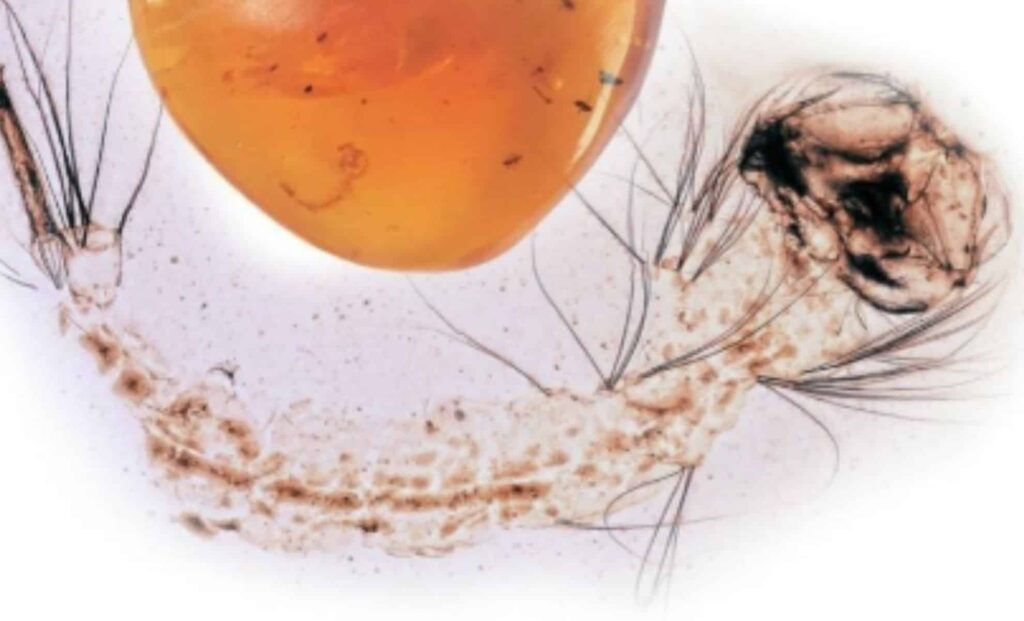Researchers from Ludwig-Maximilians-Universität München (LMU) identified the larva as a new species and genus, naming it Cretosabethes primaevus. Unlike earlier fossil finds, which often feature bizarre and extinct lineages, this ancient larva closely resembles its modern relatives, an unexpected finding that challenges decades of scientific assumptions.
The evolutionary origins of mosquitoes have long puzzled entomologists. While adult specimens from the Cretaceous have been found in amber before, these belonged to the now-extinct group Burmaculicinae, with features unlike those of any living species. This new discovery is radically different: not only is it a larva, the first ever found from this era, but it also belongs to Sabethini, a tribe that still exists today. That makes it a rare window into an ancient lineage that has barely changed in nearly 100 million years.
The fossil was found in a piece of Kachin amber dated to approximately 99 million years ago, at the boundary between the Albian and Cenomanian stages of the Late Cretaceous. The amber was sourced legally, and the fossil is now stored in the Palaeo-Evo-Devo Research Group Collection in Germany. According to a study published in Gondwana Research, the larva’s morphology provides key support for the theory that mosquitoes diversified much earlier than previously confirmed, possibly as far back as the Jurassic period.
A Snapshot of Unexpected Modernity
What sets Cretosabethes primaevus apart from other fossil mosquitoes is its anatomy. “This fossil is unique,” explains André Amaral, lead author of the study, “because the larva is very similar to modern species—in contrast to all other fossil discoveries of mosquitoes from this period, which exhibit highly unusual morphological traits that are no longer present in today’s species.” The larva has features typically associated with the Sabethini tribe, such as a distinct apical tooth on the maxilla and a particular configuration of setae, bristle-like structures used in taxonomy.
The fossil even shares character traits with specific modern genera, including Trichoprosopon, suggesting it sits deep within the evolutionary tree of today’s mosquitoes. The thorax of the larva forms a single unit, and its siphon, or breathing tube, is well-developed, common in species that live in small pools of stagnant water. Its feeding apparatus indicates that it may have been both a browser and a facultative predator, similar to some living sabethine species.
Unlike other Mesozoic mosquitoes found in amber, many of which exhibit traits not seen in any living lineage, this larva points to a surprising morphological stability. According to LMU’s findings, the larval anatomy of mosquitoes has remained relatively unchanged for close to 100 million years.

A Near-Impossible Preservation
Most amber fossils capture land-dwelling or flying insects, creatures that lived in close proximity to resin-producing trees. The odds of a mosquito larva, which lives in tiny pools of water, being encased in amber are astronomically low. That makes this find particularly rare. “For a drop of resin to fall into such a tiny pool of water and preserve an aquatic larva in amber is most unlikely,” says Amaral. This piece of amber also contains five adult Leptoconops midges and other plant debris, hinting at a likely coastal or forest edge environment.
The larva’s detailed preservation allowed for a high-resolution morphological analysis. Despite slight compression and deformation during fossilization, key features like the head shape, antenna placement, and body segmentation remain visible. According to the study, the specimen was imaged using a Keyence VHX-6000 digital microscope, with software-assisted stacking and polishing techniques used to enhance visibility.
The team believes the larva may have lived in phytotelmata—small water reservoirs formed in plant cavities—which would explain how it came into contact with resin. This is consistent with modern Sabethini behavior, as current members of the tribe often inhabit tree holes or the leaf axils of epiphytic plants.


A Challenge to the Accepted Timeline
Until now, the earliest confirmed mosquito fossils came from adults trapped in Cretaceous amber and displayed wildly different forms compared to today’s species. The new discovery of Cretosabethes primaevus shifts the timeline. According to the researchers, this fossil provides “strong support for the Jurassic origin of Culicidae,” and suggests that a major diversification event occurred well before the Late Cretaceous.
The only previous clues to such an ancient origin were indirect, based on molecular clock studies and the fossil record of mosquitoes’ closest relatives, the Chaoboridae (phantom midges). Fossils of immature chaoborids have been found in Lower Jurassic deposits, but adult mosquitoes from the same period were either absent or too ambiguous to identify confidently.
The presence of a modern-type larva from 99 million years ago implies that the divergence between mosquitoes and their sister groups happened far earlier than once thought. It also reveals that the Sabethini lineage, which today is largely found in tropical and subtropical forests, was already established during the Cretaceous period in what was then the southern part of Gondwana.

